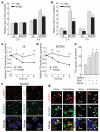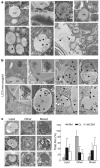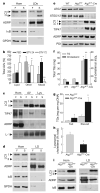Autophagy regulates lipid metabolism
- PMID: 19339967
- PMCID: PMC2676208
- DOI: 10.1038/nature07976
Autophagy regulates lipid metabolism
Abstract
The intracellular storage and utilization of lipids are critical to maintain cellular energy homeostasis. During nutrient deprivation, cellular lipids stored as triglycerides in lipid droplets are hydrolysed into fatty acids for energy. A second cellular response to starvation is the induction of autophagy, which delivers intracellular proteins and organelles sequestered in double-membrane vesicles (autophagosomes) to lysosomes for degradation and use as an energy source. Lipolysis and autophagy share similarities in regulation and function but are not known to be interrelated. Here we show a previously unknown function for autophagy in regulating intracellular lipid stores (macrolipophagy). Lipid droplets and autophagic components associated during nutrient deprivation, and inhibition of autophagy in cultured hepatocytes and mouse liver increased triglyceride storage in lipid droplets. This study identifies a critical function for autophagy in lipid metabolism that could have important implications for human diseases with lipid over-accumulation such as those that comprise the metabolic syndrome.
Figures




Comment in
-
Cell biology: Another way to get rid of fat.Nature. 2009 Apr 30;458(7242):1118-9. doi: 10.1038/4581118a. Nature. 2009. PMID: 19407787 No abstract available.
-
Dropping liver fat droplets.Hepatology. 2009 Aug;50(2):645-7. doi: 10.1002/hep.23142. Hepatology. 2009. PMID: 19642162 No abstract available.
Similar articles
-
Degradation of lipid droplet-associated proteins by chaperone-mediated autophagy facilitates lipolysis.Nat Cell Biol. 2015 Jun;17(6):759-70. doi: 10.1038/ncb3166. Epub 2015 May 11. Nat Cell Biol. 2015. PMID: 25961502 Free PMC article.
-
Autophagy-lysosomal pathway is involved in lipid degradation in rat liver.Physiol Res. 2012;61(3):287-97. doi: 10.33549/physiolres.932285. Epub 2012 Apr 5. Physiol Res. 2012. PMID: 22480422
-
Direct lysosome-based autophagy of lipid droplets in hepatocytes.Proc Natl Acad Sci U S A. 2020 Dec 22;117(51):32443-32452. doi: 10.1073/pnas.2011442117. Epub 2020 Dec 7. Proc Natl Acad Sci U S A. 2020. PMID: 33288726 Free PMC article.
-
Regulation of lipid droplets by autophagy.Trends Endocrinol Metab. 2011 Jun;22(6):234-40. doi: 10.1016/j.tem.2011.02.003. Epub 2011 Mar 16. Trends Endocrinol Metab. 2011. PMID: 21419642 Free PMC article. Review.
-
Links between autophagy and lipid droplet dynamics.J Exp Bot. 2022 May 13;73(9):2848-2858. doi: 10.1093/jxb/erac003. J Exp Bot. 2022. PMID: 35560198 Review.
Cited by
-
Thyroid in 2012: Advances in thyroid development, hormone action and neoplasia.Nat Rev Endocrinol. 2013 Feb;9(2):74-6. doi: 10.1038/nrendo.2012.253. Epub 2013 Jan 8. Nat Rev Endocrinol. 2013. PMID: 23296175 Review.
-
Ginsenoside Compound K Attenuates Ox-LDL-Mediated Macrophage Inflammation and Foam Cell Formation via Autophagy Induction and Modulating NF-κB, p38, and JNK MAPK Signaling.Front Pharmacol. 2020 Sep 15;11:567238. doi: 10.3389/fphar.2020.567238. eCollection 2020. Front Pharmacol. 2020. PMID: 33041808 Free PMC article.
-
Inflammasomes: a preclinical assessment of targeting in atherosclerosis.Expert Opin Ther Targets. 2020 Sep;24(9):825-844. doi: 10.1080/14728222.2020.1795831. Epub 2020 Aug 6. Expert Opin Ther Targets. 2020. PMID: 32757967 Free PMC article. Review.
-
Non-alcoholic Fatty Liver Disease and Alcohol-Related Liver Disease: Two Intertwined Entities.Front Med (Lausanne). 2020 Aug 20;7:448. doi: 10.3389/fmed.2020.00448. eCollection 2020. Front Med (Lausanne). 2020. PMID: 32974366 Free PMC article. Review.
-
Adiponectin knockout accentuates high fat diet-induced obesity and cardiac dysfunction: role of autophagy.Biochim Biophys Acta. 2013 Aug;1832(8):1136-48. doi: 10.1016/j.bbadis.2013.03.013. Epub 2013 Mar 21. Biochim Biophys Acta. 2013. PMID: 23524376 Free PMC article.
References
-
- Martin S, Parton RG. Lipid droplets: a unified view of a dynamic organelle. Nature Rev. Mol. Cell Biol. 2006;7:373–378. - PubMed
-
- Zechner R, Strauss JG, Haemmerle G, Lass A, Zimmermann R. Lipolysis: pathway under construction. Curr. Opin. Lipidol. 2005;16:333–340. - PubMed
-
- Finn PF, Dice JF. Proteolytic and lipolytic responses to starvation. Nutrition. 2006;22:830–844. - PubMed
Publication types
MeSH terms
Substances
Grants and funding
LinkOut - more resources
Full Text Sources
Other Literature Sources
Molecular Biology Databases

